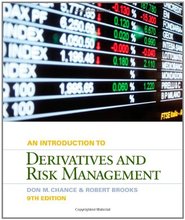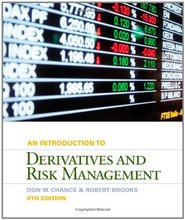This is completed downloadable of Introduction to Derivatives and Risk Management Chance 9th Edition Test Bank

Product Details:
- ISBN-10 : 1133190197
- ISBN-13 : 978-1133190196
- Author:
Give your students a solid understanding of financial derivatives and their use in managing the risks of financial decisions with this leading text. Chance/Brooks’ AN INTRODUCTION TO DERIVATIVES AND RISK MANAGEMENT, 9E offers an outstanding blend of institutional material, theory, and practical applications. The latest financial information throughout this edition and timely Internet updates on the text’s website ensure the material reflects the most recent changes in today’s financial world. You’ll find detailed, but flexible, coverage of options, futures, forwards, swaps, and risk management as well as a balanced introduction to pricing, trading, and strategy. You can easily address only the topics and chapters that best fit your needs. A variety of practical end-of-chapter applications, memorable examples from real businesses throughout the learning features, and minimal use of technical mathematics keep the text’s presentation accessible and engaging. Stock-Trak software, available with each new text, provides additional value and opportunity for practical working experience. Count on this exceptional text to provide the thorough introduction to derivatives and risk management that students need for success in financial business today.
Table of Content:
- Ch 1: Introduction
- Chapter Objectives
- Derivative Markets and Instruments
- The Underlying Asset
- Important Concepts in Financial and Derivative Markets
- Making the Connection Risk and Return and Arbitrage
- Fundamental Linkages Between Spot and Derivative Markets
- Role of Derivative Markets
- Making the Connection Jet Fuel Risk Management at Southwest Airlines
- Criticisms of Derivative Markets
- Misuses of Derivatives
- Derivatives and Ethics
- Derivatives and Your Career
- Sources of Information on Derivatives
- Book Overview
- Summary
- Key Terms
- Further Reading
- Concept Checks
- Questions and Problems
- Part I: Options
- Ch 2: Structure of Options Markets
- Chapter Objectives
- Development of Options Markets
- Call Options
- Put Options
- Over-the-Counter Options Market
- Exchange-Listed Option Trading
- Mechanics of Trading
- Option Price Quotations
- Types of Options
- Transaction Costs in Option Trading
- Regulation of Options Markets
- Summary
- Key Terms
- Further Reading
- Concept Checks
- Questions and Problems
- Appendix 2.A: Margin Requirements
- Appendix 2.B: Taxation of Option Transactions
- Ch 3: Principles of Option Pricing
- Chapter Objectives
- Basic Notation and Terminology
- Principles of Call Option Pricing
- Principles of Put Option Pricing
- Summary
- Key Terms
- Further Reading
- Concept Checks
- Questions and Problems
- Appendix 3: Dynamics of Option Boundary Conditions: A Learning Exercise
- Ch 4: Option Pricing Models: The Binomial Model
- Chapter Objectives
- One-Period Binomial Model
- Two-Period Binomial Model
- Extensions of the Binomial Model
- Summary
- Key Terms
- Further Reading
- Concept Checks
- Questions and Problems
- Ch 5: Option Pricing Models: The Black-Scholes-Merton Model
- Chapter Objectives
- Origins of the Black-Scholes-Merton Formula
- Black-Scholes-Merton Model as the Limit of the Binomial Model
- Assumptions of the Black-Scholes-Merton Model
- A Nobel Formula
- Variables in the Black-Scholes-Merton Model
- Black-Scholes-Merton Model When the Stock Pays Dividends
- Black-Scholes-Merton Model and Some Insights into American Call Options
- Put Option Pricing Models
- Managing the Risk of Options
- Summary
- Key Terms
- Further Reading
- Concept Checks
- Questions and Problems
- Appendix 5: A Shortcut to the Calculation of Implied Volatility
- Ch 6: Basic Option Strategies
- Chapter Objectives
- Terminology and Notation
- Stock Transactions
- Call Option Transactions
- Put Option Transactions
- Calls and Stock: The Covered Call
- Puts and Stock: The Protective Put
- Synthetic Puts and Calls
- Summary
- Key Terms
- Further Reading
- Concept Checks
- Questions and Problems
- Ch 7: Advanced Option Strategies
- Chapter Objectives
- Option Spreads: Basic Concepts
- Money Spreads
- Calendar Spreads
- Ratio Spreads
- Straddles
- Box Spreads
- Summary
- Key Terms
- Further Reading
- Concept Checks
- Questions and Problems
- Part II: Forwards, Futures, and Swaps
- Ch 8: The Structure of Forward and Futures Markets
- Chapter Objectives
- Development of Forward and Futures Markets
- Over-the-Counter Forward Market
- Organized Futures Trading
- Futures Traders
- Mechanics of Futures Trading
- Futures Price Quotations
- Types of Futures Contracts
- Transaction Costs in Forward and Futures Trading
- Regulation of Futures and Forward Markets
- OTC Central Clearing
- Summary
- Key Terms
- Further Reading
- Concepts Checks
- Questions and Problems
- Appendix 8: Taxation of Futures Transactions in the United States
- Ch 9: Principles of Pricing Forwards, Futures, and Options on Futures
- Chapter Objectives
- Generic Carry Arbitrage
- Carry Arbitrage When Underlying Generates Cash Flows
- Pricing Models and Risk Premiums
- Pricing Options on Futures
- Summary
- Key Terms
- Further Reading
- Concept Checks
- Questions and Problems
- Ch 10: Futures Arbitrage Strategies
- Chapter Objectives
- Short-Term Interest Rate Arbitrage
- Intermediate- and Long-Term Interest Rate Arbitrage
- Stock Index Arbitrage
- Foreign Exchange Arbitrage
- Summary
- Key Terms
- Further Reading
- Concept Checks
- Questions and Problems
- Appendix 10: Determining the CBOT Treasury Bond Conversion Factor
- Ch 11: Forward and Futures Hedging, Spread, and Target Strategies
- Chapter Objectives
- Why Hedge?
- Hedging Concepts
- Determination of the Hedge Ratio
- Hedging Strategies
- Spread Strategies
- Target Strategies
- Summary
- Key Terms
- Further Reading
- Concept Checks
- Questions and Problems
- Appendix 11: Taxation of Hedging
- Ch 12: Swaps
- Chapter Objectives
- Interest Rate Swaps
- Currency Swaps
- Equity Swaps
- Some Final Words about Swaps
- Summary
- Key Terms
- Further Reading
- Concept Checks
- Questions and Problems
- Part III: Advanced Topics
- Ch 13: Interest Rate Forwards and Options
- Chapter Objectives
- Forward Rate Agreements
- Interest Rate Options
- Interest Rate Swaptions and Forward Swaps
- Summary
- Key Terms
- Further Reading
- Concept Checks
- Questions and Problems
- Ch 14: Advanced Derivatives and Strategies
- Chapter Objectives
- Advanced Equity Derivatives and Strategies
- Advanced Interest Rate Derivatives
- Exotic Options
- Some Unusual Derivatives
- Summary
- Key Terms
- Further Reading
- Concepts Checks
- Questions and Problems
- Appendix 14: Monte Carlo Simulation
- Ch 15: Financial Risk Management Techniques and Applications
- Chapter Objectives
- Why Practice Risk Management?
- Managing Market Risk
- Managing Credit Risk
- Other Types of Risks
- Perspectives on Financial Risk Management
- Summary
- Key Terms
- Further Reading
- Concepts Checks
- Questions and Problems
- Ch 16: Managing Risk in an Organization
- Chapter Objectives
- The Structure of the Risk Management Industry
- Organizing the Risk Management Function in a Company
- Risk Management Accounting
- Risk Management Industry Standards
- Responsibilities of Senior Management
- Summary
- Key Terms
- Further Reading
- Concepts Checks
- Questions and Problems
- Appendix A: List of Important Formulas
- Appendix B: References
- Appendix C: Solutions to Concept Checks
- Glossary
- Index





